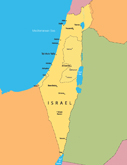×


We have detected your country as:
Please click here to go to the USA website or select another country from the dropdown list.

{image_1}
Israel will maintain a strong military presence along the eastern border of the Palestinian state—its border with Jordan—once it’s created, according to Israeli Prime Minister Benjamin Netanyahu. He told foreign reporters in Jerusalem that “the ability to proliferate into contiguous areas thousands of rockets and missiles” creates a “monumental security problem.”

{image_1}
Tel Aviv is one of the new generations of Israeli cities, literally built out of the sand in the last century. However, archaeology shows that the Tel Aviv area was inhabited thousands of years ago, thanks in part to the discovery of the remains of a prehistoric building. The Israel Antiquities Authority (IAA) reported that the building is the oldest ever found in the area and is believed to be thousands of years older than the era of Abraham and the patriarchs.

| Photo by Isranet |
Bar-Ilan University, Israel’s second-largest university, is expanding its reputation as a leading research institute by building a medical school in Safed, north of the Sea of Galilee.
Continue Reading »
{image_1}
MAKING ALIYAH—THE DREAM of a Jewish family to return to Israel, the land of their forefathers—is an exciting event in the lives of new immigrants coming to Jerusalem, Tel Aviv, Tiberias, Haifa, Beersheva, and countless other communities across Israel. But such a drastic move also involves plenty of practical considerations. There’s only so much you can pack in your suitcase, after all, and though you might like to take the kitchen sink, airline baggage regulations limit how much you can put in your luggage!

| {image_1} |
HIZBULLAH Secretary-General Hassan Nasrallah laid out his political platform on November 30 during a speech filmed by closed-circuit cameras. The platform promotes armed battle against Israel and the United States, as well as all of the latter's protectorates. “We see the US as a power that aims to impose hegemony in the region,” Nasrallah explained. “The Islamic resistance movement in Lebanon aims to fight this hegemony and the [Israeli] occupation.” He said the United States has been treating the globe as a market it aims to control, and that it was waging “a strategy of unlimited expansion.”
“The Bush administration found in September 11 a chance to impose his influence, with the excuse of a war on terror,” the Hizbullah leader said. “He tried to create a parallel between terror and resistance. There is no doubt that American terror is the source of all terror in the world. This administration gave itself the right to embark on a war of destruction, which does not distinguish between one man and the other.”
Continue Reading »
|
www.israelimages.com Naftali Hilge |
BANK OF AMERICA MERRILL LYNCH has advised international investors to temporarily avoid speculation in Dubai and focus on the Israeli stock market. The report, “Play Defense,” earmarks Israel’s banks and telecom companies as particularly promising businesses. “Israel should go back under investors’ attention,” Haim Israel, head of Research with Bank of America Merrill Lynch in Israel, told The Media Line.
Continue Reading »
{image_1}There is no such thing as a “Palestinian people.” When the Romans changed the name of Israel to Palestine, the people living in the land at the time were Jews, not Arabs.
Continue Reading »
| Picture by www.israel21c.org |
“AT FIRST, I THOUGHT I'D DIE.”That's what an ex-Mossad [Israeli intelligence] chief said about his first “operation.” Yoram Hessel, now the director of Eye from Zion, wasn't talking about a secret operation for the Israel government. He was referring to sight-restoring cataract surgery that he had witnessed firsthand.
Continue Reading »
| {image_1} |
THE ISRAELI TOURISM MINISTRY is putting money behind their words with plans to invest 15 million shekels (US $4 million) in Jerusalem during 2010. According to a press release, the funds will go towards tourism infrastructure and tourism event promotion “in order to encourage domestic and incoming tourism…This is in line with the new work plan presented by the Tourism Minister which positions Israel as the Holy Land with Jerusalem at its center.”
Continue Reading »
{image_1}On October 5, just prior to the traditional Priestly Blessing during the week of Sukkot (Feast of Tabernacles), police limited the number of Muslim worshippers allowed on the Temple Mount as a precautionary measure against possible rioting. This is a normal procedure whenever a special event takes place at the Western Wall. This time, some 150 Arabs arrived at Lions Gate and began stoning police. The Islamic Movement made statements to purposely incite Arabs, and Hamas called for a new intifada (uprising).
Continue Reading »All logos and trademarks in this site are property of their respective owner. All other materials are property of Bridges for Peace. Copyright © 2025.
Website Site Design by J-Town Internet Services Ltd. - Based in Jerusalem and Serving the World.